Singapore is one of the most progressive and innovative countries in the world.
From world-class theme parks on a man-made island, to a boat-shaped skydeck seemingly floating above buildings, to exemplary multiculturalism. There’s only one word to describe Singapore… Wow.
But none of this means “home” to the average Singaporean. To them, Singapore is all about food.
Singapore has so many restaurants and food courts that it’s not uncommon to get a little decision anxiety when choosing a place to eat. It’s kind of like choosing a movie to watch on Netflix. Once a decision is made, so many good options go flying out the window.
That's why I went on a Singapore food tour by Withlocals. The tour connects the appetites of tourists with expert Singaporean foodies who know all the best foods to try and the best places to find them.

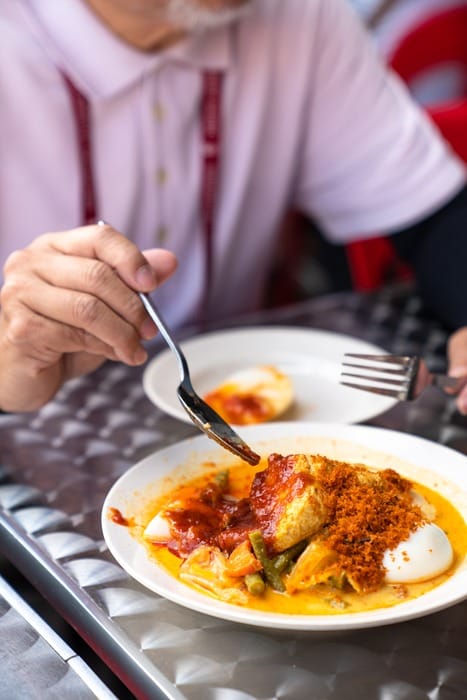
About the Tour
Withlocals’ Singapore food tour is a 3-hour private tour led by a local guide. Tours are booked online so you can select a suitable time and a guide with tastes and interests similar to your own. Tour stops are reached either by subway or on foot, so make sure to bring comfortable shoes for walking.
The tour includes tastings of 10 Singaporean foods and drinks. Some portions are small snacks and others are full-sized meals. Don’t worry about finishing every bite… the point of the tour is to sample flavours and gain an understanding of Singapore’s food culture, not make yourself full up to your nose!
Tip: The best time to start your tour is at 9am to sample a traditional breakfast and avoid the lunch hour rush at 12:30pm.

Singapore tip: While many nationalities don't need an e-visa to enter Singapore, all foreigners require submitting an "arrival card" (SGAC). You can either fill it in yourself online, or get the help of an agent.
What is Singaporean Food?
My local guide, William, explained how Singaporean food reflects the three main cultures: Malay, Chinese, and Indian. Over the years flavours have been blended and ingredients added for extra pizazz, but that’s not authentic Singaporean.
Neither is eating at nicely furnished, modern restaurants.
Locals typically eat at hawker markets serving up Malay, Chinese, and Indian street food.
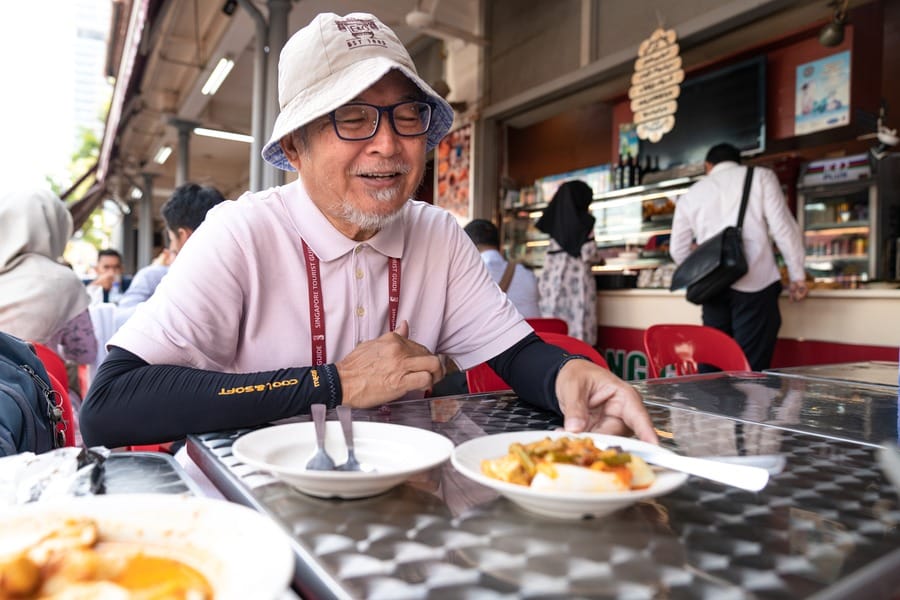
Singapore’s Hawker Market Culture
Hawker markets are easy to find in Singapore. There’s at least one in every neighbourhood and Singaporeans often eat more hawker food than home cooked meals.
It’s common to find stalls and recipes that have been handed down through generations. Most stalls only sell one cuisine or even just one dish so a full meal might be ordered from a few different venders.
Tip: the best hawker stalls tend to have longer queues. To find the best food, simply follow the long lines.

Hygiene is rarely a cause for concern in Singapore’s hawker markets. The National Environment Agency (NEA) routinely inspect each vendor and assign a hygiene rating of A,B,C, or D. Vendors are required by law to make their rating visible at all times. William said its safest to buy food from vendors rated either A or B.

Since hawker markets are such a central part of Singaporean culture, this Singapore food tour stays away from mainstream restaurants and helps tourists eat like locals at small cafes and hawker stalls.
I went to 3 different districts to try Singapore’s best food – Arab Quarter, Chinatown and Little India.
Malaysian Food
My first stop was breakfast at an original Malay café near Haji Lane in the Arab Quarter.
According to William, Malaysia has two traditional breakfast meals, Nasi Lemak and Lontong. Nasi Lemak (meaning “coconut rice”) is a serve of coconut rice topped with sides of chicken, egg, vegetable, and curries.
I ordered Lontong, a base of rice cakes topped with vegetable curry, tofu and a hard-boiled egg. This dish was undoubtedly Malay with the unmistakable blend of cloves, nutmeg, turmeric, lemongrass and chilli.

No rest for the wicked, we headed straight across the road to another Malay café, this time specialising in Teh Tarik (pulled tea). Not just specialising, but a 3rd generation expert (grandfather, father and now son). Traditional Malay tea is served hot, with sweetened condensed milk. A more flavoursome option is ginger tea.
Modern, health-conscious Malays have cut down on condensed milk and often drink Teh Tarik with evaporated milk instead.
I tried the traditional version with sweetened condensed milk and found it a little too sugary for my liking. Malays typically drink Teh Tarik followed by deep fried, crunchy curry puffs. I tried one curry puff with potato and pumpkin (my favourite) and one with sardines.
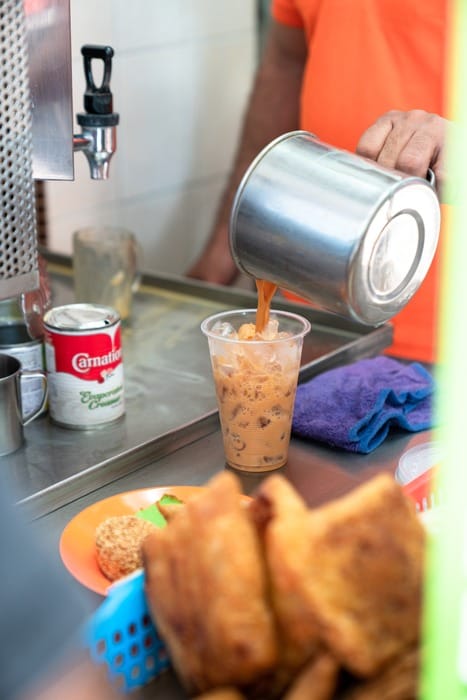
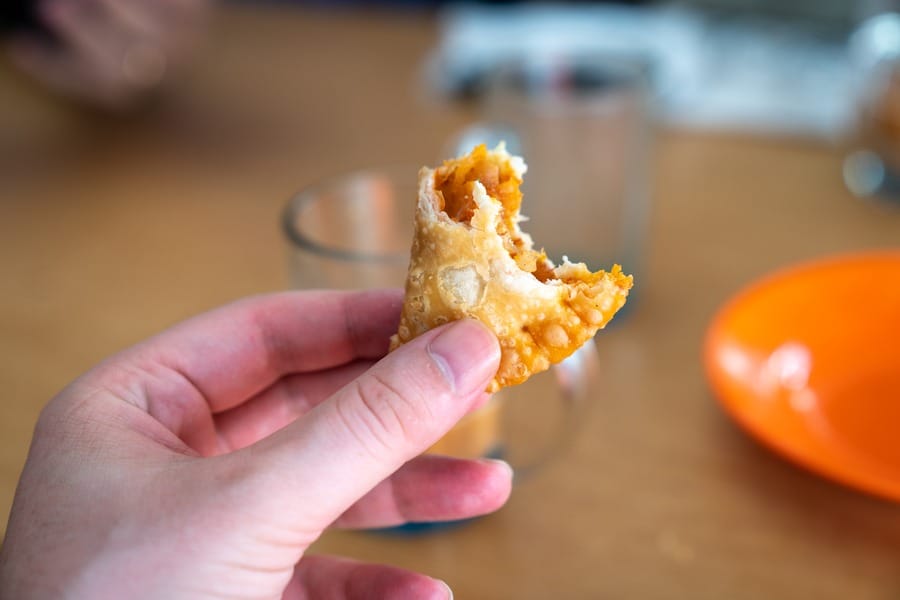

Chinese Food
Making sure to save room for round 2, we walked to the nearest MRT (Mass Rapid Transport) and took the subway to bustling Chinatown.
I noticed crowds gathering around “Food Street” but William cautioned restaurants there mainly cater to tourists so we walked further to the local favourite, Chinatown Complex. The multilevel building houses over 250 hawker stalls, including Hawker Chan, the world’s first Michelin star hawker stall that sells meals starting at $2!
We reached Chinatown around 11am and queues for Hawker Chan were already considerable. William mentioned people sometimes wait up to 90 minutes for their Michelin star hawker meal!
Instead of waiting, we made ourselves comfy at a table while William ran off to gather our next lot of delicacies. He soon reappeared with sugarcane juice, popiah, Hainanese chicken and rice, and fried carrot cake.
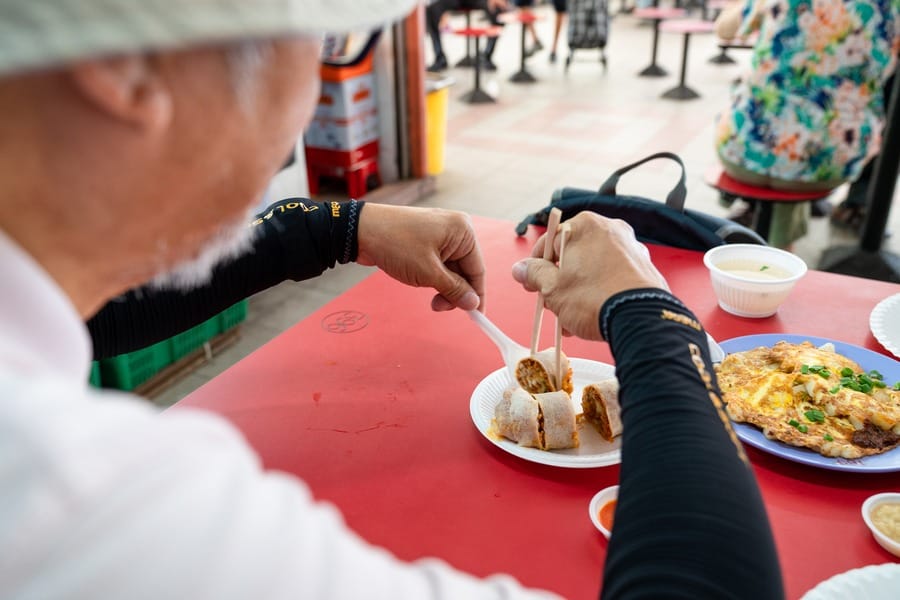
I was quite blown away by the fried carrot cake because, well, it wasn’t a cake and it wasn’t carrot. It was more like an omelette-fritter made with fried radish. But, man, did it taste good!
If I had to choose a favourite dish of the day, it would be a tie between the fried carrot cake and popiah, which is like a cross between a spring roll and satay sticks. Yum!
All of the food in Chinatown was so good that I couldn’t leave any behind, even though I still had one more tasting to come!

Indian Food
By the time we caught the MRT to Little India, I had somehow found a little more room in my stomach. Perhaps thanks to the aromatic spices that assailed my nostrils as soon as we entered the main street.
We headed straight to Tekka Market, a large hawker market with mostly Indian vendors. William mentioned the government ensure all hawker markets represent Singapore’s cultural demographic with a percentage of Chinese, Malay and Indian vendors. Even though Tekka Market is in Little India, it is required to have vendors selling Chinese and Malay food as well as Indian. It’s not uncommon to find people of these 3 descents cooking food associated with another group.
William once again ran off to collect food, this time coming back laden with mango lassi drinks, garlic and plain naan, vegetarian masala curry, and appam.


I’d never tried appam before but fell in love with it immediately. It’s a crepe with a fluffy centre yet crunchy outer rim topped with shredded coconut and brown (that’s actually bright orange) sugar. To eat it, you rip of a section of crepe, add a pinch of coconut and sugar, and fold it up like a mini sandwich. Double yum!
I’m a huge fan of Indian food and the curry and naan served here were among the best I’ve ever tasted.
My only complaint was not having enough room in my stomach! Where can I buy another stomach, please?
The Bottom Line
Singapore’s dynamic food scene is always changing. New restaurants and food markets pop up daily and the cold harsh reality is that there’s more dining options to choose from than available meals on your vacation.
If you want to make sure you try the best Malay, Chinese, and Indian food Singapore has to offer, be smart and book in a Singapore food tour by Withlocals.
Since my tour, I’ve continued navigating Singapore’s crowded hawker markets alone and found it to be quite the challenge. Finding a free table, deciding on the best stalls, and understanding strangely named dishes is no small feat.
If you really want to experience Singaporean food how locals eat it, without looking like an awkward noob, get a little help. It’s only a phonecall, er, web booking away.
Happy eating!














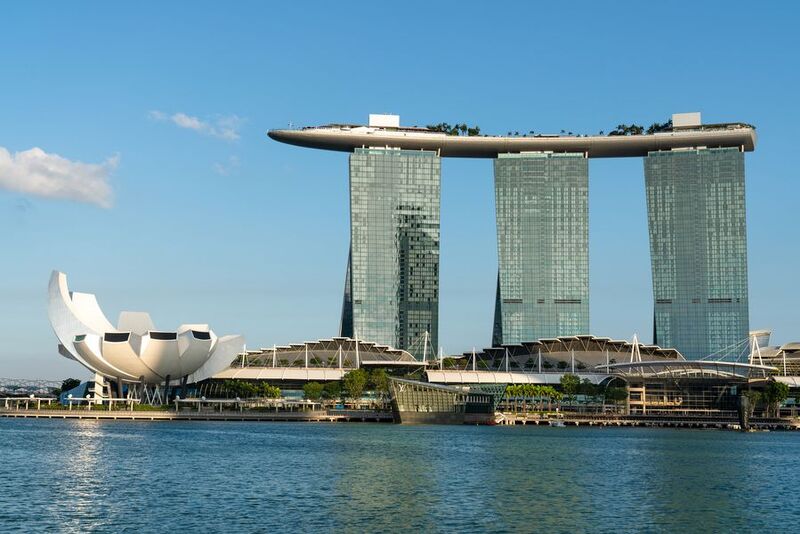



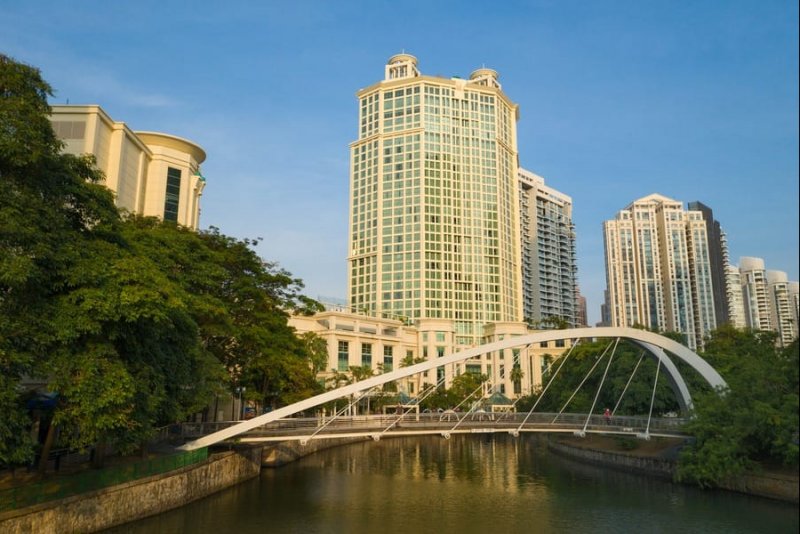







Reader Comments...
"I respond to every comment by direct private email. I look forward to your feedback" - Josh BenderThis all looks delicious! I bet you were pretty full after everything was over. I really want to try the fried carrot cake.
I had never thought of going for a food tour but the pictorial of this has pushed me to go and plan one. Please visit Uganda and enjoy more taste food!
Nice post! The awesome hawker stalls was one of my favourite things about Singapore.
Thanks for your good information
I think American food courts could learn a thing or two from The Hawker Center.
Wonderful article. Could you please suggest me some fun things to do in Singapore?
Your blog has been incredibly helpful to me, and I want to express my sincere gratitude for the effort you've invested in creating it. Thank you so much for your valuable insights.
Write Your Comment
Please DO NOT include links, URLs or HTML in your comments - they will be automated deleted and you will waste your time.